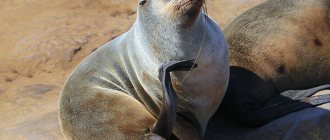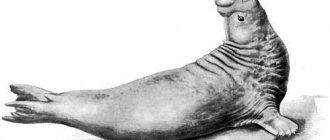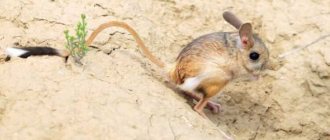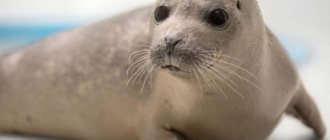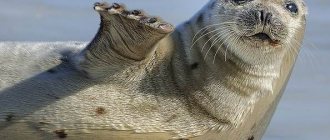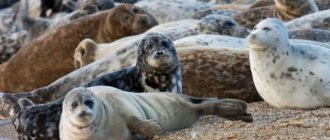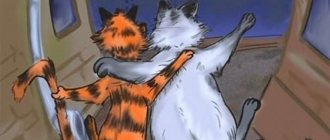Pinnipeds (Pinnipedia), an order of carnivorous mammals that are well adapted to life in water, but cannot exist completely independently of land.
Pinnipeds include seals and walruses. Also on topic:
MAMMALS
Their body is usually covered with fur, which helps retain heat. Thermal insulation is also provided by a very thick layer of subcutaneous fatty tissue, which, in addition, serves as a source of energy in case of lack of food.
The streamlined body shape facilitates rapid movement in the water. The limbs are transformed into flippers, with the front ones being used mainly as rudders and the rear ones as rowing blades. Pinnipeds do not swim as fast as cetaceans, but some species reach speeds of up to 27 km/h on the surface and 16 km/h underwater. These are quite dexterous animals: they are able, for example, to climb out onto a jagged cliff during a strong surf without receiving a single scratch, but on land they are clumsy and move with difficulty, mainly pushing off with their forelimbs.
Also on topic:
WALRUS
Pinnipeds tend to live in large groups. During the breeding season, they gather in huge colonies (“rookeries”), sometimes numbering more than a million individuals. Most species are polygamous. Some pinnipeds lead a solitary lifestyle, but even they gather in small groups during breeding. These are mainly marine animals, but several species live in lakes or enter rivers. Pinnipeds are especially numerous in areas with cold climates, particularly around polar ice, but seals and sea lions can be found in the coastal waters of most seas and oceans of the globe.
These animals feed on fish, cephalopods and other mollusks, crustaceans, large plankton, seabirds, other pinnipeds, and sometimes even cetaceans. Their main enemies are sharks, killer whales, polar bears and leopard seals, with maximum mortality occurring in the first six months of life. At least once a year, all pinnipeds come ashore or onto pack ice, where they mate and give birth to young. Pregnancy lasts from 8 to almost 12 months. Puberty occurs at the age of 3–5 years.
Also on topic:
PREDATORY
Pinnipeds are divided into three families: eared seals (Otariidae), seals (Phocidae), and walrus seals (Odobenidae). The first two families include 20 genera, 31 species and approximately 16 geographical races or subspecies. Walruses are represented by one genus.
Northern fur seal
(Callorhinus ursinus) is famous for its magnificent soft and durable fur. The body length of an adult male (cleaver) is up to 2 m, weight more than 300 kg; the color is dark, chocolate brown, sometimes almost black, with grayish shoulders and neck. Females are smaller and more graceful, no more than 1.2 m long; their neck is long and thin, their fur is grayish. It consists of an outer layer of long, shiny guard hairs covering a thick, soft undercoat.
The northern fur seal is a herd animal. It feeds mainly on schooling fish (primarily herring) and squid. The lifestyle is conservative, subject to a strict “schedule”. During winter migrations in the Pacific Ocean, herds of these animals, heading south, swim almost 1000 km and reach the latitudes of California. In the spring they return to the islands in the Bering and Okhotsk seas, where they reproduce. Choppers are the first to appear at rookeries in April-May, choosing better places and defending them in fights with their fellows. Each individual site occupies a strip of beach 25–30 m long. Weaker (“haremless”) males have to be content with places located further from the shore and wait there for a random female. Young males not allowed to mate form their own small groups. Mature pregnant females (queens) arrive on the islands between mid-June and mid-July. On the shore, each of them is met by the male who happens to be closest to the others and takes them to his area. The female gives birth to one calf, usually a few hours after arrival, a maximum of two days.
A very large, strong billcutter may have up to 100 females in its “harem,” but usually there are 40–50. To maintain it, the male has to remain nearby all the time, going without food for at least two months, and often much longer. The cleaver “does not trust” either his partners or his neighbors and stands on duty day and night, constantly declaring his rights to those around him with a deafening roar. By the beginning of August, all females that have already given birth are covered again. Exhausted and emaciated from the hunger strike, the cleavers return to the sea and feed there with their brothers. But the mating season is not over yet. At this time, thousands of virgin two-year-old females arrive on the coast for the first mating.
The cubs, covered with shiny blackish-brown fur, are born sighted. At 6–8 weeks of age they begin to swim. The mother feeds them for 4 months, until the start of winter migration. Only a few babies reach puberty; About half of them are eaten by sharks and killer whales in the first year of life.
Notes[ | ]
- Pinnipeds / Zharikov K. A. // Epiphany - Swallows. - M.: Great Russian Encyclopedia, 2010. - P. 740. - (Big Russian Encyclopedia: [in 35 volumes] / chief editor Yu. S. Osipov; 2004-2017, vol. 16). — ISBN 978-5-85270-347-7.
- ↑ 1 2 Burgin CJ, Widness J., Upham NS
Introduction to Illustrated Checklist of the Mammals of the World // Illustrated Checklist of the Mammals of the World (English) / ed. by Burgin CJ, Wilson DE, Mittermeier RA, Rylands AB, Lacher TE, Sechrest W. - Lynx Editions[en], 2022. - P. 27. - ISBN 978-84-16728-36-7. - Berta, A. (2009). "Pinnipedia, overview", pp. 881–884 in Perrin, Würsig and Thewissen.
- Karleskin, G.;
Turner, R.L.; Small, JW Introduction to Marine Biology (unspecified). - Cengage Learning (English) (Russian, 2009. - P. 328. - ISBN 978-0-495-56197-2. - ↑ 12
A. Bram, Animal Life / Animal Life in Stories and Pictures according to A. Bram, ed. B. M. Zhitkov and N. S. Dorovatovsky. — T. 1. Mammals. - M.: SP “Slovo”, 1992. - Violetta R. Beklemisheva, Polina L. Perelman, Natalya A. Lemskaya, Anastasia I. Kulemzina, Anastasia A. Proskuryakova, Vladimir N. Burkanov, Alexander S. Graphodatsky The Ancestral Carnivore Karyotype As Substantiated by Comparative Chromosome Painting of Three Pinnipeds, the Walrus , the Steller Sea Lion and the Baikal Seal (Pinnipedia, Carnivora) // PLOS ONE, 01/28/2016
- John J. Flynn, John A. Finarelli, Sarah Zehr, Johnny Hsu, Michael A. Nedbal.
Molecular Phylogeny of the Carnivora (Mammalia): Assessing the Impact of Increased Sampling on Resolving Enigmatic Relationships // Systematic Biology. - 2005. - Vol. 54, iss. 2. - P. 317–337. — ISSN 1063-5157. - doi:10.1080/10635150590923326. - The “missing link” of seal evolution has been found - Science and technology - History, archeology, paleontology - Paleontology - Compulenta inaccessible
link). Access date: September 10, 2011. Archived October 27, 2011.
Southern fur seals
(Arctocephalus) – medium-sized seals. Males are blackish-brown and have a thick mane of long, coarse guard hairs on their shoulders; body length up to 1.8 m, and weight (in different species) from 225 to 320 kg; females are much smaller, yellowish-gray.
Externally, southern fur seals are very similar to northern fur seals, but their fur is of slightly worse quality. Previously, they were widespread in the warm southern seas: in the Pacific Ocean - from Mexico to the Strait of Magellan, off the southeastern coast of South America, off South Africa, Australia and New Zealand.
California sea lion
(Zalophus californianus) is the most famous of all seals and is the one commonly seen in zoos and the circus ring. His coat is shiny and rather coarse, without soft undercoat, the color is chocolate brown, the ears are small, and the tail is very short. Sizes are medium; the mass of large males reaches 300 kg with a body length of approx. 2.5 m; females are smaller and more graceful - up to 1.8 m long.
In the spring, the cleaver gathers around him a group of pregnant females, but this harem is never large, and the cleaver does not guard it very jealously, even finding time to feed. Soon after arriving at the rookery, females give birth to young. They are born sighted, covered with lush fur and able to move independently. The mother feeds the baby for 3–4 months. The lifespan of these animals is approximately 20 years.
The California sea lion's main food source is squid, although it also eats fish.
Description of the animal
All types of seals belong to predatory mammals from the suborder Canidae. They are peculiar animals, the external structure of which is somewhat different from other representatives of the class.
The seal looks unusual. Its body is spindle-shaped, its head is small, and its body becomes narrower towards the tail. It ends with a tail. The forelimbs are transformed into flippers, with their help the animal swims well, but moves rather slowly and awkwardly on land. In real seals, the front flippers are located much closer to the head.
An interesting anatomical feature of seals is the absence of external auricles . The neck of individuals is thick, short and almost motionless. The eyes are large, the large pupil is colored black. In addition to the front ones, seals have rear flippers, which are constantly straightened and cannot serve as support during movement.
Representatives of the family have vibrissae on the upper lip (from 6 to 10 rows). They are less rigid than those of walruses, but perform an olfactory function, like those of other mammals. The flippers have rather sharp claws, only in some members of the family they are reduced. Seals have thick skin and subcutaneous fatty tissue. Animals are able to accumulate fat in large quantities, and then get rid of it, quickly decreasing in size.
The sweat glands of seals are poorly developed . The skin of young individuals has a pronounced fur coat; adult seals gradually lose it. Their soft fur is replaced by hard, thick and short hairs.
The length and body weight of animals varies greatly. There are small mammals, they weigh no more than 100 kg, and the body has a length of 120 cm. Large seals reach 6 meters in length and have a mass of 3.5 tons.
Sea lion
(Eumetopias jubata) is the largest of the eared seals. It was described by the German biologist G. Steller, who named the species the sea lion (Leo marinus): the males, with their massive neck and withers, relatively slender rear half of the body and golden eyes, reminded him of the king of beasts.
The color of sea lions is yellowish-brown; The body length of a large cleaver reaches 4 m, and its mass is a whole ton. However, in most cases they are no longer than 3 m and no heavier than 700 kg. Females are much smaller and have a lighter build; their body length is 2.5 m and their weight is approximately 350 kg.
In the spring and summer, sea lions breed on the northern coasts of the Pacific Ocean, including Alaska, and spend the winter months in the warm waters off the coast of Mexico. Their harems are small; with one male there are rarely more than 12 females. The weight of a newborn sea lion varies from 16 to 23 kg, depending on gender, and by two months they can weigh up to 45 kg. Babies are born sighted and very soon begin to quickly crawl over rocks, dodging huge adult animals that can accidentally crush them.
Population and species status
Photo: What an eared seal looks like
Eared seals are listed in the Red Book and have the status of “Species with declining numbers throughout most of their habitat.” The animals are especially protected and hunting them is prohibited. Seals play a significant role in marine ecosystems. The existence of a species is important for the conservation of biological diversity.
This species is protected in the Koryaksky, Komandorsky, Kronetsnorsky nature reserves. The destruction of animals is punishable by law in the Russian Federation and many countries. A large fine is imposed for catching and killing eared seals.
REAL SEALS
True seals (family Phocidae) are well adapted to life in cold seas: their entire body, including a short tail and flippers, is covered with thick, coarse hair that protects them from icy water, biting winds, snow and ice. Under the skin there is a thick layer of fat.
The auricles of seals are completely absent; in their place, only a small hole is noticeable on each side of the head. But these animals are not deaf, and some of them even have good hearing, especially in water. The hind limbs, which serve as the main locomotor organ when swimming, are extended back, do not bend or tuck under the body, like in eared seals, so they are not used when moving on land. On the front flippers, which serve mainly as rudders in the water, five fingers connected by membranes are clearly visible.
Seals can regulate their body temperature
A layer of blubber, or blubber, insulates the seal's body, and the circulatory system diverts blood flow to the limbs and outer surface of the body. As a result, seals can walk onto the ice without melting it. Their thick fur gives them protection from the cold and also holds water on their skin, which warms up to body temperature.
The relatively small surface area of the body relative to their total volume reduces the amount of heat lost to the environment. Seals regulate temperature through behavioral means, such as changing position in the sun, moving to damp areas or shallow pools, and changing activity levels.
Photo: Phil Botha
harbor seal
(Phoca vitulina) is often found off the sea coasts of temperate regions of the Northern Hemisphere. It never swims far from land and sometimes settles in fresh lakes and large rivers.
This is a relatively small animal. The body length of an adult male is approximately 1.5 m and weight is 45 kg; the female is about the same. The head is round, the eyes are large, the muzzle is as if chopped off, the body is stocky, with a short neck. The color varies from yellowish-gray with dark brown spots to almost black with white spots.
The harbor seal does not form large colonies; it spends more time on the shore than other seals and cannot sleep in the water. Families consisting of a male, several females and their cubs of different ages often use the same place for overnight stays, which becomes their group territory. These are very friendly animals that are easy to tame.
Cubs (sometimes twins) are born in early spring. Newborns of the Far Eastern form are covered with fluffy white fur that lasts for 3–4 weeks (the pup stage). In other forms, this fur sheds immediately, sometimes even before birth. The baby's cry resembles the bleating of a lamb. His mother feeds him for about 5 weeks, after which he learns to forage for food himself. The common seal feeds on a variety of fish (capelin, navaga, herring, flounder, pollock, etc.), as well as squid and octopus.
The species' range extends along both Atlantic coasts from southern New Jersey and the northern Mediterranean to the polar ice boundary, and along the Far Eastern and American coasts of the Pacific Ocean - from Kamchatka in the north to Baja California in the south.
The Ungave subspecies of the common seal (Pv mellonae) lives only in Upper Seal and Lower Seal lakes (translated as Upper and Lower Seal) 150 km east of Hudson Bay. How it penetrated these inland bodies of water remains a mystery; perhaps their settlement occurred during the retreat of the glacier.
Interesting Facts
Some species of the family are considered a real mystery because experts have not been able to study their lifestyle. The most interesting facts about seals are:
- seals live in almost every corner of the planet;
- fur seals can spend more than 6 months in the ocean searching for food;
- animals are clumsy on land, but in water they reach speeds of up to 25 km/h;
- an individual can stay directly under water for no longer than 10 minutes; only elephant seals are capable of remaining at a depth of 1500 meters for 2 hours;
- You can determine the age of a seal by the number of circles located at the base of their fangs;
- individuals are capable of crying, just like humans;
- The sebaceous glands of seals are poorly developed;
- in case of danger, several individuals unite in a flock, the rest of the time they prefer to be alone;
- most species are peaceful in nature (with the exception of elephant seals and leopards), they almost never quarrel;
- despite the large eyes, the mammal’s vision is not so well developed, all individuals suffer from myopia;
- The seal can detect sounds and smells at a distance of 500 meters;
- the smallest species of seal is the Ladoga seal, which lives in Lake Ladoga, its body length does not exceed 135 cm;
- Small seals and their pups are often hunted by sharks;
- The female's milk has a very high fat content, reaching 50%.
Representatives of the true seal family are interesting and peaceful mammals. They play an important role in the ecosystem. That is why many animal rights activists oppose the hunting of these mysterious inhabitants of the seas, lakes and oceans.
Ringed seal, or Akiba
(Pusa [Phoca] hispida), covered with coarse blackish-brown fur with numerous irregular white rings. The body length of an adult male is up to 1.8 m.
This is the only seal of all that builds a nest for its young. In March or April, when the ice begins to break, the female makes a burrow in a snowdrift with a tunnel leading to a vent and water. Newborns (sometimes twins) are covered with snow-white soft fur (the pup stage), which after a month gives way to darker fur.
The ringed seal appears to travel the furthest north of any mammal; She spends most of the year in ice-covered bays and fiords. In autumn, as the water freezes, the animal does not migrate south, but makes holes in the ice, to which it regularly swims up to breathe and rest. Sometimes this leads to a sad result, since a hunter with a harpoon or a polar bear may be waiting for him near such an opening. Usually the seal spends 8–9 minutes under water, but if necessary, it can remain there for up to 20 minutes. When she surfaces, she manages to stock up on air for the next dive in 45 seconds.
The ringed seal is distributed circumpolarly in the Arctic Ocean, reaching as far south as Labrador and the Bering Sea.
Vision and hearing help seals hunt
Their vision is adapted to prolonged exposure to water. The seal's eye is adapted for vision in low light levels thanks to a lining (similar to a cat's eye) that reflects and amplifies weak light in deep water. Their eyes, with round lenses (like those of fish) and large irises, open completely underwater. At the surface, their pupils are narrowed by the iris into tiny holes that protect the retina from bright light.
Seals hear perfectly underwater. They are able to perceive sound in a wide range of frequencies, far exceeding the range of human hearing. The lack of ear flaps in most seals and the heavy wax coating in the ear canal reduces their ability to perceive sounds in the air. Their ears are valved and close in water. Their nostrils are also valved and closed at rest.
Photo: Fred Heap
The vibrissae, or whiskers, located on the head are extremely sensitive and help seals hunt in complete darkness by allowing them to sense the vibrations created by their moving prey.
Harp seal, or coot
(Pagophilus [Pagophoca] groenlandica), larger than the ringed seal. The length of a mature male exceeds 2 m, and the weight reaches 360 kg; females are almost the same in size, but differ in color. Adult males are yellowish-white, with a wide dark brown stripe on the side, which connects with the opposite one on the withers and in the rump area, forming a pattern reminiscent of a saddle or harp. The muzzle is also black and brown. Females are light gray, and they either have no dark stripes at all or are blurry.
The female usually gives birth to one cub in March, rarely twins. The newborn is covered with snow-white soft fur (the white stage), which after about a month, when the baby is ready to start swimming, is replaced by coarse light gray fur (the serk stage). By the beginning of May, the mother stops feeding her offspring, and the young seal begins to get its own food. It reaches sexual maturity at four years of age; by this time the male has a characteristic pattern.
The harp seal has a more pronounced herd lifestyle than all other seals, and its population is also the highest: it is estimated at 4 million individuals. Some herds contain up to 500,000 animals. This seal is constantly nomadic, moving through open water along the edge of ice fields. Its range covers the North Atlantic and Arctic from Canada to Severnaya Zemlya and extends south to the latitude of Newfoundland; the American population breeds on the ice just north of this island and the Gulf of St. Lawrence. In the spring, when the ice begins to break, huge herds migrate north, reaching the shores of Greenland.
This animal swims at speeds of up to 32 km/h, dives to depths of up to 60 m and can remain underwater for up to 20 minutes. It feeds on fish, mainly cod, and some crustaceans.
Birds
Flying
Antarctic tern
The Antarctic tern is a typical representative of the tern family. It is a small bird 31-38 cm long, weighing 95-120 g, and with a wingspan of 66-77 cm. Its beak is usually dark red or blackish. The plumage is mostly light gray or white, with a black “cap” on the head. The tips of the wings of this tern are grayish-black.
They feed on fish and krill, especially when in Antarctica. Terns spot their prey from the air and then dive into the water after it.
Antarctic Blue-eyed Cormorant
The Antarctic blue-eyed cormorant is the only member of the cormorant family that is found in Antarctica. They live along the South Antilles Ridge and the Antarctic Peninsula, going deeper to the south. These cormorants are characterized by bright eye color and an orange-yellow growth at the base of the bill, which becomes especially large and colorful during the breeding season. Body weight is 1.8-3.5 kg, with males slightly heavier than females. The body length varies from 68 to 76 cm, and the wingspan is about 1.1 m.
They feed primarily on fish, often forming a "trap" of tens or hundreds of birds that repeatedly dive into the water and help each other catch fish. These cormorants are capable of diving to depths of up to 116 m. When swimming, they press their wings tightly to their body and use their webbed feet.
Snowy Plover
The Snowy Plover is one of two species of the genus Chionidae. She prefers a terrestrial lifestyle. When walking, it nods its head like a dove. Body weight varies from 460 to 780 g, body length is 34-41 cm, and wingspan is 75-80 cm.
The snowy plover does not have webbed feet, so it finds its food on the ground. She is an omnivore and is characterized by kleptoparasitism (stealing krill and fish from penguins, and sometimes eating eggs and chicks). It also feeds on carrion and animal excrement, and, where possible, human waste.
Pintado
The Cape Dove belongs to the shearwater family. Its weight is up to 430 g, body length is 39 cm, and its wingspan reaches 86 cm. The color of the feathers of this bird is black and white.
The Cape bluegill feeds on krill, fish, squid, carrion and ship waste, if available. They usually catch prey on the surface of the water, but sometimes dive shallowly.
Snow petrel
Snow petrels are white birds with black beaks and eyes. They are the size of a pigeon and are perhaps the most beautiful of all Antarctic birds. The body length is 30-40 cm, the wingspan is 75-95 cm, and the weight is 240-460 g.
They feed mainly on krill and must always be close to the sea to have access to food. They are found along the coast of Antarctica, and are known to nest far inland (up to 325 km from the coast), in mountains that jut out above the surrounding ice.
wandering albatross
The wandering albatross is the bird with the longest wingspan (3.1 to 3.5 m). This bird can make long flights of 10-20 days, over a distance of up to 10,000 km, using barely more energy than when sitting on the nest.
Average weight ranges from 5.9 to 12.7 kg, males are approximately 20% heavier than females. Body length varies from 107 to 135 cm.
The diet is based on fish, squid and crustaceans. The bird hunts at night on the surface of the water or by diving shallowly. Wandering albatrosses follow boats and vessels of any type where food is dropped. This is especially true for fishing vessels that throw fish waste overboard.
South polar skua
The South Pole Skua is a fairly large bird. Males average weight 900-1600g and they tend to be slightly smaller and lighter than females. Average length: 50-55 cm, and wingspan 130-140 cm. They nest in continental Antarctica and breed far to the south. These birds have been recorded at the South Pole.
They feed primarily on fish and krill, although penguin eggs, chicks and carrion may also be included in the diet, depending on the habitat. South polar skuas have been observed stealing fish from other bird species.
Southern giant petrel
The southern giant petrel is a bird of prey from the petrel family. Their weight is 5 kg and their body length is 87 cm. The wingspan varies from 180 to 205 cm.
The diet consists of dead seal and penguin carcasses, carrion, squid, krill, crustaceans, and waste from ships or fishing boats.
Most often, these birds are found on the Antarctic and subantarctic islands. They nest in open ground on the Falkland Islands.
Flightless
Emperor penguin
Emperor penguins are the largest penguins in the world, with an average weight of about 30 kg (but can reach 40 kg), and a height of 1.15 m. Males and females have similar colors and body sizes. The back and head are black, the belly is white, the chest is pale yellow, and there are bright yellow spots in the ear area. Like all penguins, they are wingless, with a streamlined body and wings flattened into flippers for their marine habitat.
Its diet consists primarily of fish, but may also include crustaceans and cephalopods. When hunting, these birds can remain underwater for up to 18 minutes and dive to a depth of 535 m. It has several adaptations for this, including unusually structured hemoglobin, hard bones and the ability to reduce metabolism.
The emperor penguin nests in cold environments. The species has adapted in several ways to counteract heat loss: its feathers provide 80-90% insulation, and it has a layer of subcutaneous fat that reaches 3 cm in thickness; the downy undercoat, in combination with the plumage, plays a decisive role in keeping the bird warm; The process of preening the feathers is vital in providing insulation and in keeping the plumage oily and water-repellent.
King Penguin
The king penguin is the second largest penguin species after the emperor. Height ranges from 70 to 100 cm, and weight from 9.3 to 18 kg. Males are slightly larger than females. The plumage of king penguins is much brighter than that of their close relative the emperor, but is otherwise similar.
King penguins eat small fish and squid. They can dive to depths of 100 m, but have also been seen at depths of over 300 m. Fish makes up 80-100% of their diet, except during the winter months of the year.
King penguins breed on the subantarctic islands, in the northern regions of Antarctica, as well as on Tierra del Fuego, the Falkland Islands and other temperate islands.
Subantarctic penguin
Subantarctic penguin, also known as the gentoo penguin. It is easily recognized by the broad white stripe running across the top of its head and its striking orange-red beak. This species has pale webbed feet, and a fairly long tail - the most prominent of all penguins.
The gentoo penguin reaches a height of 51 to 90 cm, making them the third largest penguin species, after the two giant species: emperor and king penguins. Males have a maximum weight of about 8.5 kg, just before molting, and a minimum weight of about 4.9 kg, before mating. In females, the weight ranges from 4.5 to 8.2 kg. This species is the fastest underwater, reaching speeds of up to 36 km/h. They are perfectly adapted to very harsh climatic conditions.
Subantarctic penguins feed mainly on crustaceans, with fish making up only about 15% of the diet.
Striped seal or lionfish
(Histriophoca [Phoca] fasciata), a small animal, close in size to the common seal, but at the same time the most conspicuous of all pinnipeds. The color of the male is reddish-brown, almost black, with wide white rings around the neck, rump and bases of the front flippers; females are fawn-gray with a narrow stripe at the back. The length of the male is approximately 1.7 m, the female is approx. 1.5 m.
The range of the striped seal is small: the northern part of the Pacific Ocean, from the Aleutian to the Kuril Islands. Total number approx. 25,000 individuals. Very little is known about the lifestyle. Seals live in groups of several individuals, apparently in families.
Origin of the species
It is known that the ancestors of pinniped mammals once walked freely on the earth. Later, perhaps due to worsening climatic conditions, they were forced to sink into the water. Moreover, most likely, true and eared seals originated from different animals.
Scientists believe that the ancestors of the true, or common, seal were otter-like creatures that were found in the North Atlantic fifteen million years ago. The eared seal is more ancient - its ancestors, dog-like mammals, lived twenty-five million years ago in the northern latitudes of the Pacific Ocean.
Long-faced, gray seal, or tevyak
(Halichoerus grypus), large animal: the length of an adult male is more than 3 m and weighs up to 300 kg; female length is 2.5 m. Color varies from light gray to dark gray; Some individuals have dark spots of different sizes scattered unevenly throughout the body.
The long-faced seal never gathers in large herds; its colonies usually consist of small groups scattered over a relatively large area; each of them includes a male, three or four females and their young. At the end of August, seasoned males climb high stones to lie in the sun. Sometimes conflicts arise between them, accompanied by loud roars, for convenient places.
These seals are found on both sides of the Atlantic Ocean, at the latitude of southern Canada and the British Isles, never going further south, where the water is warmer, or north, into the ice fields. In September, females come ashore and a few hours later give birth to one calf, either simply on the beach or in grottoes under the rocks. The newborn (belek) is covered with snow-white fur and weighs approximately 14 kg; he is sighted and able to move independently. Helping itself with its hind limbs, it waddles, almost like a land animal, but after 2–3 days it loses this ability. In the first days, the mother does not leave the baby, she protects, caresses him and even scratches his back. 10 days after giving birth, the female is again ready for mating. The cub grows quickly and at two weeks of age can already weigh 38 kg. After a month, the white fur gives way to gray. At this time, the mother stops feeding the baby and loses interest in him. For two weeks it survives mainly on accumulated fat, but soon hunger drives it into the water, where it quickly learns to find food. The long-snouted seal feeds mainly on fish (cod, flounder, salmon), as well as mollusks and crustaceans.
Although males fight fiercely for their territories, they do not create lasting harems, and if a female goes to a neighbor, the former partner does not show any signs of jealousy.
They eat a lot of seafood
Seals regularly dive to depths of 70-300 meters in search of food. They mainly consume fish, squid, shrimp, as well as other crustaceans, molluscs and zooplankton. Most of them also feed on seabirds (if they manage to catch them). Large species of seals can eat 5-6 kg of food per day. As some populations have increased in recent decades, seals have also begun to feed on commercially valuable fish species such as salmon and salmon.
In zoos, seals are fed herring, capelin, squid and mackerel twice a day. They receive daily vitamin supplements to replace the nutrients lost during the freezing process of the fish.
Sea hare or bearded seal
(Erignathus barbatus), one of the largest seals. The body length of an adult male is approx. 3 m with a mass of 360 kg, but there are also specimens up to 3.7 m long and weighing up to 700 kg. Females are much smaller, slightly longer than 2 m. The sea hare's jaws are powerful, but the teeth are small, weak and often wear out and fall out before old age. A characteristic feature of the species is numerous long and flattened vibrissae (“whiskers”) hanging from the upper lip.
The newborn sea hare is covered in thick, dark gray fur; after two weeks, the skin becomes blue-gray, and in adult seals the hair is coarse, yellowish-gray, without pronounced markings.
The sea hare lives on coastal ice in the northern Atlantic and Pacific oceans from Newfoundland to Norway and from Alaska to Sakhalin, reaching the polar ice fields. It feeds mainly on crustaceans and mollusks, for which it often dives to considerable depths.
Leopard seal
(Hydrurga leptonyx) is the only seal that regularly feeds on warm-blooded animals. This is a large Antarctic animal: the length of the male is up to 3 m, and the length of the female is up to 3.5 m. The fur is coarse, yellowish-gray, with numerous black spots of irregular shape. The canines are long and sharp, and the molars have three points, forming a sharp cutting edge for tearing meat.
The lifestyle of the leopard seal has been poorly studied. It hunts other seals, penguins, and sometimes small dolphins and fish. The animals are found mostly alone, sometimes gathering in migrating herds, but their migration routes are unknown.
The species is distributed from the ice fields of Antarctica to New Zealand, Australia and the Falkland Islands.
Khokhlach
(Cystophora cristata) is a bluish-gray animal with numerous yellowish-white spots of irregular shape. A sexually mature male (over 2.5 m long) has a kind of leathery sac on his muzzle that stretches from the tip of his nose to the top of his head. When excited, the animal inflates it, so that the entire upper part of the head becomes like a melon. Female length approx. 1.8 m. The front flippers of the crested deer are small, and the rear ones are wide, fan-shaped, with a very large claw on the outer toe.
These seals do not gather in large herds, but form family groups consisting of a large male, two or three females and pups of different ages. The mating season is in March. Males fight for females, but their fights are noisy rather than violent: they inflate their bags and then forcefully release the air from them, emitting a roar that can be heard over a radius of several kilometers. The baby is born about a year later. Its soft snow-white fur is shed during the first molt, which occurs in the womb, and it is born covered with short and rather coarse ash-gray hair. Sexual maturity occurs in the fourth year, but the crested cat matures only at the age of five.
This pelagic animal rarely approaches land. It lives in the Arctic and often coexists with the harp seal on ice fields, but the two species stay separate: the hooded seal prefers inner pack ice, and the harp seal prefers thin fast ice.
Differences in body structure
The unrelated origin of these two groups of seals is confirmed by a significant difference in the structure of their skeletons. Thus, the common seal is almost helpless on land. On the shore, he lies on his stomach, his front flippers stick out to the sides, and his hind flippers drag along the ground when moving, like a fish tail. To move forward, the animal is forced to constantly jump, moving its very heavy body.
The eared seal, in contrast, rests firmly on all four limbs. At the same time, its front flippers have fairly powerful muscles, allowing them to withstand quite a significant body weight, and the rear flippers do not drag behind, but are turned forward and located under the belly. Usually this animal “waddles”, using all its flippers while walking, and if necessary, it can “waddle” at a very decent speed. Thus, a fur seal is able to run along a rocky shore even faster than a person.
Monk seals
(Monachus) – medium size; The length of the male is up to 2.5 m. The color ranges from dark brown to grayish-brown. They live in warm seas, where competition with other seals is minimal. Animals live in small family groups or colonies. Newborn cubs are covered with long and soft blackish fur.
The Caribbean or tropical monk seal (M. tropicalis) used to be common in the West Indies. Now he is close to extinction. The Mediterranean monk seal (M. monachus) is still quite common in the Mediterranean, Black and Adriatic Seas, and around Madeira, the Canary Islands and other islands off the west coast of Africa. The Hawaiian monk seal (M. schauinslandi) lives in the western part of the Hawaiian archipelago.
Status of pinnipeds in modern mammalian systems[ | ]
Skeleton of an eared seal (above) and a true seal (below)
According to modern molecular data, pinnipeds represent a monophyletic group[6]. Historically, pinnipeds were previously classified as a separate order. The group was later considered polyphyletic, and pinnipeds were divided into two different superfamilies within the order Carnivora. Eared seals and walruses belong to the superfamily Otariidea, and true seals belong to Phocidea (in addition, there are a number of other fossil families).
Otariidea was considered the sister group to Ursidae, with the earliest remains of modern families found in the Pacific Basin, although the first records of extinct families are known from the Oligocene of France; a Phocidea was associated with mustelids, early remains were found in the Mediterranean Sea - in the Atlantic, known from the early Miocene.
| Caniformia (Canidae) | |
| Odobenidae (Walrus) | |
(Real seals)
Musteloidea (Martens)| Procyonidae (Raccoons) | |
There are significant differences between the two groups in both the structure of the skull and the structure of the rest of the skeleton, which lead to different modes of locomotion. In the modern classification, pinnipeds are preserved as a parvoorder within the order Carnivora[2][7].
Elephant seals
(Mirounga) are the largest animals not only among true seals, but also among all pinnipeds, including the walrus. The length of an adult male is often 5.5 m (sometimes up to 6.7 m) with a weight of up to 3.5 tons. Females are smaller, about 3 m long. Elephant seals have rough, wrinkled skin, covered with short and sparse brown hair. When an animal sheds, the top layer of skin swells with bubbles and comes off in long strips along with the fur. The end of the male's muzzle is extended into a kind of trunk made of spongy tissue, usually hanging down in the form of a bag. During the mating season, the elephant seal greatly inflates it, and then forcefully releases the air outward: in this case, the trunk acts as a resonating chamber, and the roar of the animal is heard within a radius of several kilometers.
Animals swim rhythmically, quickly and even gracefully. They can dive deep in search of food; They feed on fish, including sharks, mollusks, crustaceans, and algae. The animal's stomach contains pebbles that help break down food. In the spring, elephant seals gather on the shore in colonies. Between February and June, the females move away from the herd and give birth to one young at a time, covered with black fur, in secluded places. On the shore, the elephant seal sleeps a lot and basks in the hot sun. If you wake him up carelessly, he throws sand and small stones at the offender with his front flippers.
Elephant seals are divided into two species. Northern elephant seals (M. angustirostris) have been common off the coast of California and Mexico in the past. Its herds numbered thousands of individuals, but between 1855 and 1870 they were so actively hunted for fat that the species was brought to the brink of extinction. Currently, the number of elephant seals is growing.
The southern elephant seal (M. leonina) has a circumpolar distribution in sub-Antarctic waters. It migrates regularly, going far into the open ocean and changing feeding areas depending on the time of year. During the breeding season, it reaches the north of the islands of South Georgia and Lobos in the South Atlantic Ocean.
Seals use voice, smell and tactility to communicate.
They have a variety of vocalizations, many of which are used during mating season. Males hiss and growl to demonstrate dominance and aggression. They also practice non-vocal communication such as neck biting and open-mouthed silent threats. Slapping and scratching with flippers are common signs of irritation in females.
Photo: mana5280
Males produce strong scents during the breeding season, and mothers also identify their young by scent. They are also characterized by tactile communication using antennae. Olfactory, visual and acoustic signals are also part of the mother-calf recognition system. The young produce characteristic calls that can be heard at a distance of up to a kilometer. Recognition of mothers and cubs is possible even after 4 years of separation.
